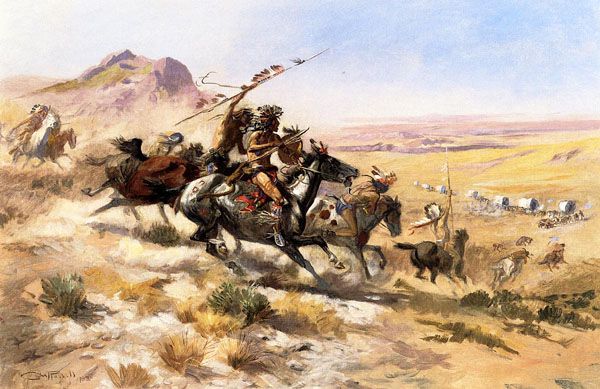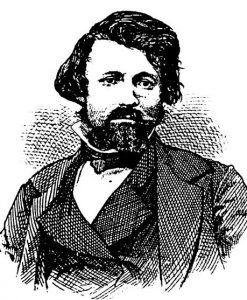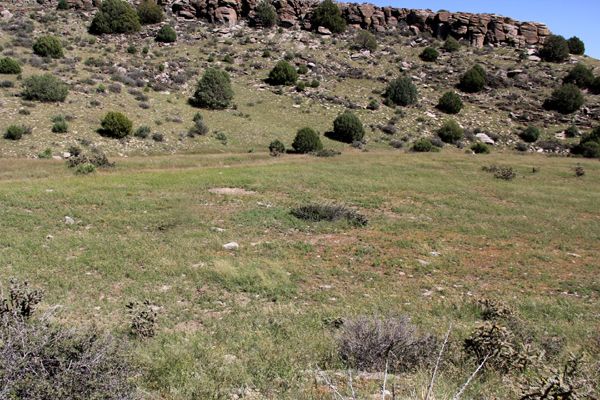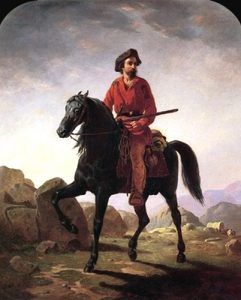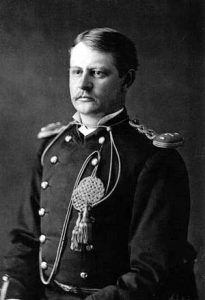The White Massacre on the Santa Fe Trail in New Mexico – Legends of America (original) (raw)
Indian attack on a wagon train by Charles Marion Russell
The White Massacre occurred in northeastern New Mexico in October 1849 when the Jicarilla Apache attacked a wagon train near the Point of Rocks on the Cimarron Branch of the Santa Fe Trail.
Brothers James and Charles White of Warsaw, Missouri, sought their fortune in New Mexico, arriving in Santa Fe in July 1848, where they opened a mercantile business. That month, they ran an ad in the Santa Fe Republican describing their store: “Cheap Merchants — cheaper than the cheapest.” After a successful trade summer, Charles headed south to explore other business prospects between Santa Fe and Chihuahua, Mexico. In the meantime, James returned to Missouri to bank $58,000 in gold and silver coins.
In February 1849, Charles White, and Francois Aubry, a French Canadian merchant and explorer of the American Southwest, traveled to Chihuahua, Mexico, via El Paso, Texas. At some point, Aubry and Charles White established a new mercantile in El Paso. After they had wholesaled their goods, Aubry returned to Independence, Missouri, on August 23. Along the way, his caravan had been attacked by both Apache and Pawnee. Still, they suffered no losses, and Aubry immediately purchased goods for a return trip to Santa Fe. There, James White also made plans to return to Santa Fe, bringing along his wife Ann Dunn and their young daughter Virginia, with plans to make Santa Fe their new home.
During the summer of 1849, Santa Fe Trail traffic had been grave for several wagon trains, many of them had been attacked, or their stock was driven off. The turmoil prompted Santa Fe Indian Agent James Calhoun to request more troops on August 15, noting that “the Indians, generally, are in a bad temper — the number of troops is not sufficient here to keep up on them a proper check.”
Francis Xavier Aubry
Though they heard about the danger, Francois Aubry, who was leading the caravan, and James White were determined to make the trip. Aubry’s caravan included ten wagons owned by Ceran St. Vrain and 13 wagons owned by James White. Along with James White were his wife, Ann, daughter Virginia, a mulatto employee named Ben Bushman, and a black female servant who acted as a nurse to baby Virginia. The wagon train departed Westport, Missouri, on September 15. Despite the dire warnings of Indian unrest, the journey initially proved uneventful.
Aubry decided to send his wagon master, William Calloway, ahead to Santa Fe for fresh mules at some point along the trail. James White, who considered himself “a veteran of the trail,” decided to go with him to get his family to Santa Fe more quickly. Aubry argued against this idea, but James was determined. He loaded his wife, daughter, employee Ben Bushman, and nursemaid into two carriages. They were accompanied by a German traveler named Lawberger and two of Aubry’s Mexican employees.
After they passed the dangerous part of the trip along the Cimarron Cutoff of the Santa Fe Trail, they paused a few miles east of the Point of Rocks landmark in New Mexico. On October 24, they were approached by a band of Jicarilla Apache and Ute Indians asking for gifts. Refusing their request, the Indians were sent away. The Indians returned several times but were again rebuked. The warriors then attacked the detachment, killing all men and sparing only Ann White, her child, and her servant, whom they took as captives.
Point of Rocks on the Santa Fe Trail, New Mexico
A very short time later, a group of buffalo hunters came upon the scene. They, too, were attacked by the Apache and hastily retreated, leaving behind two of their group who had been killed. However, one of those who had been shot, the young son of a buffalo hunter, wasn’t dead. Having played possum during the attack, he soon went to Point of Rocks, where he told his tale.
When Indian Agent James Calhoun received word of the attack on October 29, he hired an Indian trader named Encarnacion Garcia to negotiate a ransom of 1000forthereturnofcaptives.AubryreachedSantaFethenextday,offeredanother1000 for the return of captives. Aubry reached Santa Fe the next day, offered another 1000forthereturnofcaptives.AubryreachedSantaFethenextday,offeredanother1000 for their release, and promptly hired Pueblo Indians and New Mexican friends to rescue the captives.
Kit Carson in 1854 by William Ranney
Troops were also set in motion from Taos, where Captain William Grier organized the 42 men of his company of the First Dragoons, along with 40 mounted New Mexican Volunteers under Captain Jose Valdez. They were joined by experienced guides Antoine Leroux, Robert Fisher, Dick Wootton, Jesus Silva, and Tom Tobin. On the third night out, Grier’s detachment reached Rayado, where Kit Carson joined them. The troops then made their way to the attack site near Point of Rocks, arriving on November 9, more than two weeks after the attack.
They followed the Indians’ trail for about 200 miles, finally tracking them to an encampment on the Canadian River a few miles south of Tucumcari Butte. The soldiers attacked the camp in the early morning of November 17, and the Indians fled. There, the troops found the dead body of Ann White, which was still warm. Grier surmised that she refused to go with the Indians, and they had killed her as the troops approached.
Kit Carson would later say in his autobiography:
“We tracked them for ten or twelve days over the most difficult trail that I have ever followed…
We finally came in view of the Indian camp. I was in advance, starting for their camp, calling for the men to follow. The [commanding] officer called a halt; none of them would follow me. I was informed that Leroux, the principal guide, told the officer in command to halt that the Indians wanted to have a parley. The Jicarilla started packing their goods for flight, and a shot was fired that struck Captain Grier, causing no serious injury. The captain ordered a charge, but the delay allowed all but one of the Indians to escape. In about 200 yards, pursuing the Indians, the body of Mrs. White was found, perfectly warm, had not been killed more than five minutes – shot through the heart by an arrow… I am certain that if the Indians had been charged immediately on our arrival, she would have been saved…However, the treatment she had received…was so brutal and horrible that she could not possibly have lived very long.
We found a book in the camp, the first of the kind I had ever seen, in which I was represented as a great hero, slaying Indians by the hundred. I have often thought that Mrs. White must have read it, and knowing that I lived nearby, must have prayed for my appearance in order that she might be saved. I did come, but I lacked the power to persuade those that were in command over me to follow my plan for her rescue.”
The book was most likely Charles Averill’s Kit Carson: Prince of the Gold Hunters, published earlier that year and the first of many novels to wildly exaggerate Carson’s heroics. Disgusted, Carson urged his companions to toss the book into the fire over Ann White’s grave. The failure of his ride to save Ann White would haunt him all the rest of his days.
After the attack, the troops pursued the Indians for several miles, killing one warrior, taking several horses, and capturing “all their baggage and camp equipage.” Neither the daughter, Virginia White, nor her black nursemaid were found. On their return, the troops were struck by a sudden blizzard, and the men suffered terribly. Grier’s black servant was lost in the storm. On November 24, the men staggered into Captain Judd’s camp at Las Vegas, New Mexico, where Kit Carson left the command for Rayado. The rest of the troops continued to Taos, arriving on November 29.
Afterward, William Bransford, a merchant at Mora, New Mexico, offered two horses and one-half the trade goods in his store for the girl’s recovery. Still, many of the local men who traded with the Indians and some of the Indians declared that she was dead.
Indian agent James Calhoun
In February 1850, Congress authorized $1,500 to be paid by Indian agent James Calhoun for the return of Virginia White. Calhoun then sent Auguste Lacome, a noted scout, trader, and mountaineer, and Encarnacion Garcia, also a trader, to inquire into their location and whether they could be ransomed. Lacome met with several Ute Indians affiliated with the Jicarilla Apache and confirmed that the child had been killed shortly after the camp attack, and her body was thrown in a river. The servant was killed a short time later, unable to keep up with the band.
The White Massacre received considerable publicity and marked the beginning of the Jicarilla War. Six months later, in May 1850, a group of mail carriers was killed in the Wagon Mound Massacre.
In response to these depredations, Indian Agent James Calhoun finally got his request for more troops, and in 1851 Fort Union was built near where the Cimarron and Mountain branches of the Santa Fe Trail met. From there, the army would relentlessly pursue the Jicarilla Apache until they were finally subdued in 1854.
© Kathy Alexander/Legends of America, updated April 2023.
Fort Union, New Mexico, by Kathy Alexander.
Also See:
Francois Aubry – Merchant and Explorer of the Southwest
Indian Terrors on the Santa Fe Trail
Kit Carson – Legend of the Southwest
Sources:
